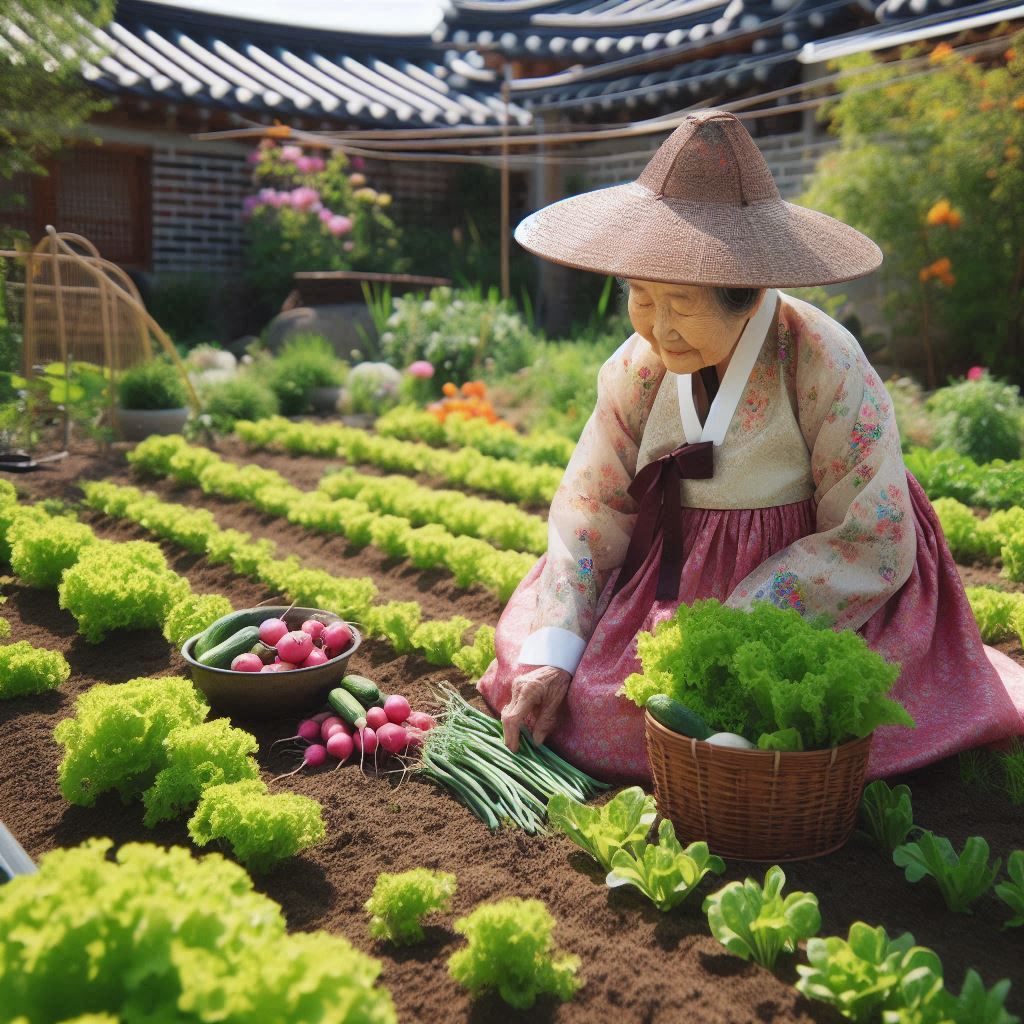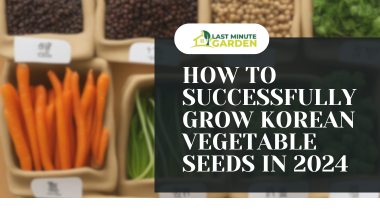
Growing your favorite food has never been more satisfying, especially when it involves unique and flavorful crops like Korean vegetable seeds. Korean vegetables are a subset of Asian vegetables, but they have distinct characteristics and uses specific to Korean cuisine.
Planting these seeds in your home garden can provide fresh and unusual items to your kitchen, whether your preference is for napa cabbage, perilla leaves, Korean onions, or traditional Korean chili peppers.
In this article, I’ll walk you through how to successfully grow Korean vegetable seeds in 2024. And yes, I’ll show you how buying vegetable seeds on eBay might be a wonderful choice to kickstart your Korean vegetable garden.
Why Grow Korean Vegetables?
Growing Korea-based vegetables is a fantastic way to diversify your garden and your diet. Korean cuisine is well-known for its balance of spicy, flowery, sweet, and tangy flavors; mustard seeds and many of the vegetables used in traditional dishes are also highly nutritious.
Asia and Korean vegetables offer a variety of nutritious and flavorful options, but the distinction lies in the cultural context and the traditional dishes they are used for. These vegetables, known for their vibrant flavors and nutrition-packed profiles, are now increasingly popular among gardeners worldwide.
If you’re a fan of homemade kimchi, bibimbap, broccoli, or Korean barbecues, having these vegetables on hand will make preparing these meals easier and fresher.
Plus, some of the vegetables, like perilla leaves, cucumber, and Korean peppers, can be difficult to find in local stores, making it all the more rewarding to grow them yourself and gain 100 percent profit.
How To Grow Korean Vegetable Seeds
1. Choosing the Right Korean Vegetable Seeds
The first step in growing Korean vegetable seeds is selecting the right seeds. Fortunately, there are numerous places to buy Korean vegetable seeds, and online marketplaces or shops like eBay offer an impressive variety.
In addition, it is easier to buy vegetable seeds on eBay, but you can also get uncommon and heirloom varieties that you might not discover at your local nursery. You can also get wholesale seeds there.
When purchasing from online sellers, check reviews to ensure the seeds are high quality and come from reputable sellers, especially when shipping. You’ll want seeds that have amazing germination rates, especially if you’re a beginner or working in a new garden.
Always opt for organic or untreated seeds when possible, as these are better for your soil and environment. This can save you money and produce healthy vegetables.
Some of the best Korean vegetables to consider growing include:
- Napa cabbage (Baechu) is essential for making kimchi.
- Korean chili peppers (Gochu) are perfect for adding a kick to any dish.
- Perilla leaves (Kkaennip) are commonly used as wraps or in salads.
- Korean radish (Mu) adds crunch to soups and stews.
Buying Korean Vegetable Seeds on eBay
Buying Korean vegetable seeds on eBay is straightforward. First, visit the eBay website and create an account or log in. Next, use the search bar to enter Korean vegetable seeds and browse the results. Filter your search by selecting categories or sellers with high ratings for reliability.
Review product descriptions, paying attention to seed variety, germination rates, and seller feedback. Once you find suitable seeds, click on the listing for more details. If you’re satisfied, add the item to your cart and proceed to checkout.
Finally, select your payment method and complete the purchase to enjoy your gardening journey.
2. Preparing Your Garden for Korean Vegetables
Once you’ve selected your seeds, the next step is to prepare your garden for planting. Korean vegetable seeds typically require well-draining, fertile soil. Here’s how you can set the stage for successful growth:
- Location: Choose a sunny spot in your garden. Korean vegetables, especially those like chili peppers and napa cabbage, thrive in full sunlight, requiring at least 6-8 hours of sunlight per day.
- Soil Preparation: Enrich your garden soil by mixing in organic compost or well-rotted manure. This helps to fertilize the soil for excellent growth. This boosts soil fertility, providing the necessary nutrients for healthy growth. Korean vegetables also benefit from soil that retains moisture but drains well to avoid root rot.
- Spacing and Layout: When sowing your seeds, ensure that you space them according to their specific needs. For instance, napa cabbage requires around 12-18 inches between plants, while perilla leaves need about 8-10 inches of space to grow comfortably. Proper spacing prevents overcrowding, promoting air circulation and reducing the risk of diseases.
- Timing: For most Korean vegetables, late spring is the perfect time to sow seeds directly into the garden. However, some, like napa cabbage and Korean radish, may benefit from being planted in the cooler months, such as early spring or late summer, to avoid the heat stress of midsummer.
3. Planting and Watering
Once your garden bed is ready, it’s time to plant your Korean vegetable seeds. Follow these key steps:
- Sowing Depth: Depending on the vegetable, plant your seeds at the recommended depth. Napa cabbage seeds, for example, should be sown about ¼ inch deep, while Korean chili peppers can be placed slightly deeper at ½ inch. Make sure to cover the seeds lightly with soil.
- Watering: After planting, water thoroughly to help the seeds settle into the soil. During the growing season, keep the soil consistently moist but not waterlogged. Mulching around the plants helps retain soil moisture and protects against temperature fluctuations.
- Fertilization: While most Korean vegetables grow well with moderate fertilization, be cautious not to overdo it. A balanced organic fertilizer applied every few weeks during the growing season should suffice. Remember to avoid high-nitrogen fertilizers, as these can promote excessive leaf growth at the expense of the vegetables themselves.
4. Caring for Your Growing Plants
After planting, consistent care is key to a successful harvest. Here are a few tips for maintaining your Korean vegetable garden:
- Weeding: Regularly remove weeds around your plants, as they compete for nutrients and water. Hand-pulling weeds is usually the best method for a smaller garden.
- Pest Control: Korean vegetables are susceptible to pests like aphids and caterpillars. Fortunately, by planting in the fall or early spring, you’ll minimize insect pressure. Using organic pest control methods such as neem oil or insecticidal soap can keep pests in check without harming your plants.
- Thinning: If your seedlings are overcrowded, thin them to allow adequate space for growth. Thinning ensures that each plant has enough room to establish a strong root system, leading to healthier plants and a better harvest.
5. Harvesting Korean Vegetables
As the growing season progresses, your Korean vegetables will begin to mature, and it will soon be time to enjoy the fruits of your labor.
- Napa Cabbage: Typically ready for harvest in 70-90 days, napa cabbage is best harvested when the heads are firm and full. Simply cut the heads at the base, leaving the roots in the soil for potential regrowth.
- Korean Chili Peppers: Gochu peppers are generally ready for picking once they reach their full size and have turned a deep red color. Depending on your climate, this can take 60-80 days.
- Perilla Leaves: Perilla leaves can be harvested continuously throughout the growing season. Simply snip off the outer leaves as needed, allowing the plant to continue producing new foliage.
Enjoying Your Homegrown Korean Vegetables
Now that you’ve harvested your Korean vegetables, it’s time to savor the rewards of your hard work. These fresh, nutrient-rich vegetables can be used in a variety of traditional Korean dishes, including:
- Mu salad: Thinly slice mu (Korean radish) and toss it with gochugaru (Korean chili flakes), sesame oil, and green onions for a refreshing side dish.
- Chwinamul stir-fry: Stir-fry chwinamul (Korean wild greens) with garlic, soy sauce, and a touch of sesame oil for a quick, healthy meal.
- Perilla garnish: Use fresh perilla leaves to enhance bibimbap, grilled meats, or rice dishes with their bold, herbal flavor.
Korean vegetables are not only flavorful but also rich in vitamins and minerals, making them a fantastic addition to your diet.
Storage
Korean vegetables like napa cabbage, radishes, and perilla leaves should be stored in a cool, dry place. Napa cabbage and radishes can be refrigerated and wrapped in plastic. Perilla leaves are best stored in an airtight container. For longer storage, vegetables like strawberries can be picked or fermented.
Growing Korean Vegetables Indoors
If you don’t have outdoor space or live in a colder climate, you can still grow Korean vegetables indoors. Here are some tips to get started:
- Containers: Choose pots with good drainage holes. The size of the container should be suitable for the plant’s mature size—larger vegetables like napa cabbage will need bigger pots.
- Lighting: Place your pots near a sunny window, or use grow lights to provide at least 6-8 hours of light daily.
- Watering: Indoor plants tend to dry out quicker than those outdoors. Water them more frequently, but make sure the soil drains well to avoid waterlogging.
Final Thoughts
Growing Korean vegetable seeds in 2024 can be an exciting and rewarding experience for any gardener. With this, we can eat healthily. With the right preparation, direction, care, and attention, your garden will yield an abundance of fresh, flavorful vegetables that can transform your home-cooked meals.
By planning and following the steps outlined in this guide, you’ll be well on your way to enjoying a thriving Korean vegetable garden next season. Sign up to get all our latest gardening updates. Happy gardening!




